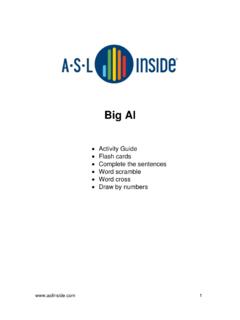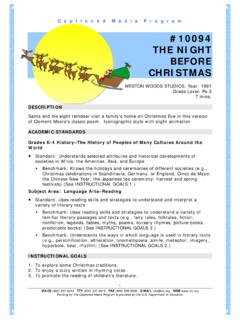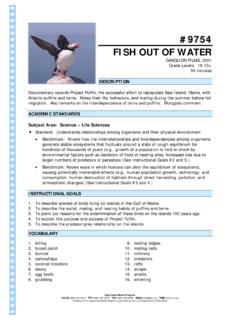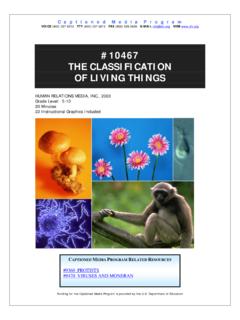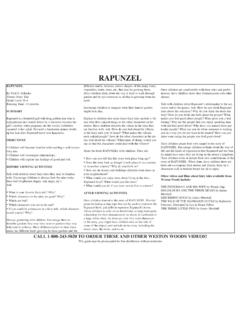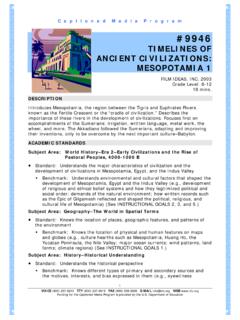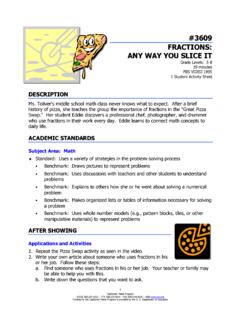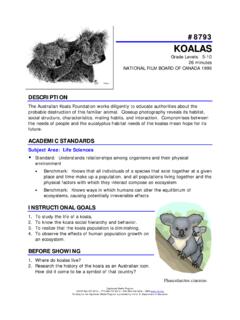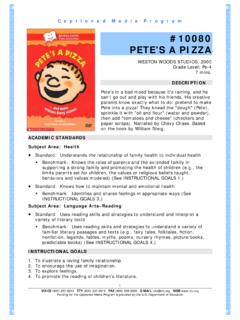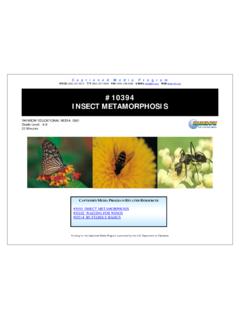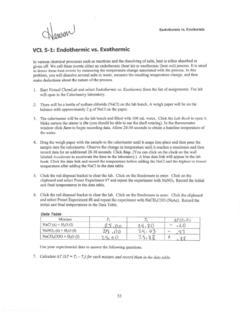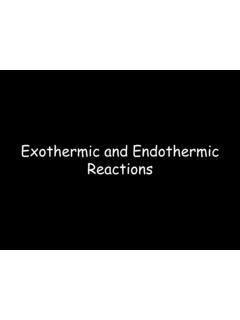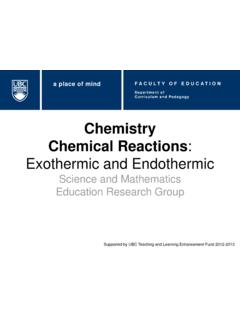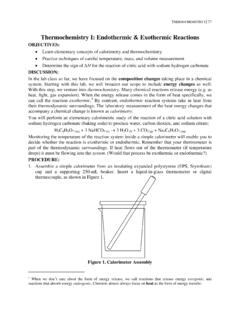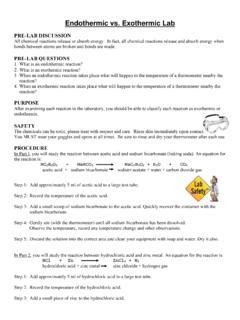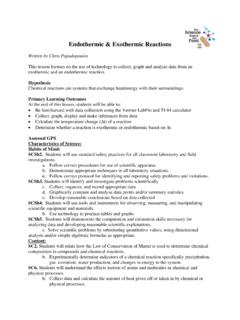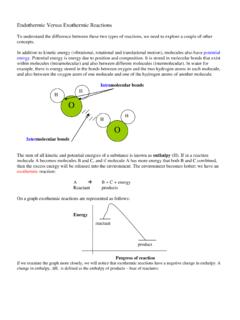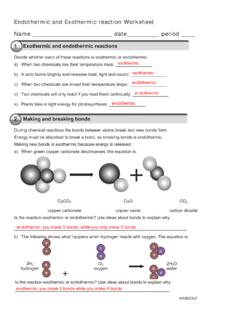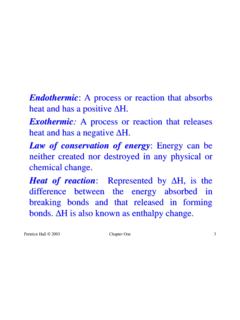Transcription of The Energy in Chemical Reactions - The Described and ...
1 1 UNIT 7 The Energy in Chemical ReactionsThermochemistry and Reaction EnergiesUnit OverviewUnit 7 introduces students to thermochemistry, the study of Energy in Chemical Reactions . After completing this unit, students should be able to understand the various types of Energy along with basic thermodynamic terms: system, surroundings, heat, and work. The unit also explains the first law of thermodynamics and provides an introduction to enthalpy and Objectives and Applicable StandardsParticipants will be able to:1 . Describe the different kinds of Energy : kinetic, potential, Chemical , and . Describe how the internal Energy of a system can increase or decrease through heat and . Explain the First Law of Thermodynamics (the conservation of Energy ) and give exam-ples of one form of Energy converting into . Define the terms endothermic and.
2 Describe Hess s Law and what it is used . Explain how bond enthalpies can be used to find the change in enthalpy ( H) of a Concepts and People1 . Kinetic and Potential Energy : Objects can possess both kinetic and potential Energy . When a substance goes through a phase change, its particles gain or lose kinetic . Energy Changes in Chemistry: Chemical Energy is potential Energy that is stored in Chemical bonds. This Energy can be released by exchanging high Energy bonds for low Energy bonds. Thermal Energy is the total Energy of all of the molecules in a . Heat, Work, and Internal Energy : Heat and work are not Energy , but rather describe ways Energy enters and leaves a . Energy Conversions and Conservation: While Energy frequently changes from one form to another, the total amount of Energy in an isolated system does not change.
3 The First Law of Thermodynamics explains that Energy cannot be created nor . Enthalpy: The change in enthalpy ( H) expresses the amount of heat produced or absorbed by a Chemical reaction at constant pressure. Chemical Reactions either release heat ( exothermic ) or absorb heat ( endothermic ). 6 . Calorimetry: A calorimeter is a container that can measure the amount of heat released or absorbed by any Chemical . Hess s Law: Hess s Law explains that the change in enthalpy of a Chemical reaction depends only on the enthalpy of the reactants and the products, and not on anything that happens in between. 8 . Bond Enthalpies: Breaking Chemical bonds requires enthalpy ( endothermic ), and forming Chemical bonds releases enthalpy ( exothermic ). Determining if a Chemical re-action as a whole is endothermic or exothermic depends on whether or not breaking the old Chemical bonds requires more enthalpy than the enthalpy released from forming the new Chemical bonds.
4 The amount of enthalpy associated with a bond is called bond enthalpy. 9 . Standard Enthalpies of Formation: The standard enthalpy of formation refers to the enthalpy change of the formation of one mole of a compound from its constituent elements in their most stable state at 1 atm of pressure and 25 phrase Chemical reaction conjures up images of explosions, bubbling gases, flames, and smoke. So many Chemical Reactions have visible results because Energy is being transferred from one form to another the realm of thermodynamics. Thermodynamics provides rules for predicting the progress of a reaction and for harnessing the Energy released. It is key to solving pressing engineering problems, such as making the next generation of cleaner, and more efficient, automobile engines. VIDEO CONTENTHost Introduction exothermic Reactions Dr.
5 Nicole Labbe, a Chemical engineer at the Argonne National Laboratory at the University of Chicago, introduces the first law of thermodynamics and enthalpy by describing what happens when a log burns. UNIT 7 The Energy in Chemical Reactions3 Laboratory Demonstration Flame Tornado Daniel Rosenberg, Lecture Demonstrator at Harvard University, creates a flame tornado to show a visually stunning example of an exothermic reaction. Laboratory Demonstration Heat Absorber To show an endothermic reaction, Daniel Rosenberg reacts barium hydroxide and ammonium chloride. To prove the reaction is endothermic , he places water between a block of wood and the beaker in which the reaction is taking place. Because the reaction is endothermic , it takes enthalpy from the surroundings, which means it takes some enthalpy from the water between the beaker and the block.
6 This causes the water to Science Explanation Measuring Heat Dr. Nicole Labbe demonstrates how a coffee cup calorimeter is used to measure the heat released when sodium hydroxide dissolves in World Application Mississippi Biofuels By using bomb calorimetry, Dr. Gretchen Sassenrath is leading a study for the Department of Agriculture to determine which crops in Mississippi could best serve as a potential alternative fuel Science Explanation Bond Enthalpy Dr. Nicole Labbe explains how to calculate values of enthalpies of a given reaction by looking up the bond enthalpies of the products and reactants of that reaction. Chemists have been doing experiments for hundreds of years to determine bond enthalpies for various chemicals, which are now compiled in tables. Bond enthalpies can help predict the mechanism of a given of ChemistryIn thermodynamics, work is any transfer of Energy in a system that is not a heat transfer.
7 Work can create heat, and heat can create work. During the days of steam power, scientists wondered if an engine could perform a heat to-work conversion with 100% efficiency. Using a theoretical piston engine, Nicolas Leonard Sadi Carnot (1798-1832), a French military engineer and phys-icist, was the first to realize that it is impossible. Carnot s discovery led to the second law of thermodynamics. Current Chemistry Research Fighting the 2nd Law Kevin Cedrone, a graduate student at MIT s Sloan Automotive Lab, studies how to get as much work out of an engine as possible. He strives to get engines to run as cleanly and efficiently as 7 The Energy in Chemical Reactions4 Unit TextContent OverviewEnergy is the ability to do work, and it comes in many forms. The unit begins with a discussion of kinetic Energy , potential Energy , thermal Energy , latent heats of fusion/vaporization, and Chemical Energy .
8 These last three forms of Energy make up the internal Energy of a system. A system can exchange Energy with the surroundings in the forms of heat and/or work. Next, the unit discusses the work of Thomson and Joule, which demonstrated that Energy can-not be created nor destroyed (the First Law of Thermodynamics), but it can be converted from one form to First Law of Thermodynamics is followed by a discussion of enthalpy. The enthalpy change ( H) of a system is the change in internal Energy plus the work done by or to the system. H can be positive ( endothermic ) or negative ( exothermic ). Calorimeters are used to measure the enthalpy change of a reaction. The final sections of the unit cover bond enthalpy and the Energy values of food. Sidebar Content1 . State Functions: This sidebar explains the difference between state and path-depen-dent.
9 Food Energy : Gram for gram, fat stores more Energy than protein and carbohydrates. 3 . Nitrogen s Triple Bond: The Haber-Bosch process is an industrial process that converts nitrogen gas (N2), into fertilizer, which contains nitrogen that plants can use to grow. The Haber-Bosch process has also made the production of explosives more Historical Timeline of ChemistryThis interactive illustrates how different discoveries build upon, disprove, or reinforce previous theories. This not only reinforces basic chemistry concepts, but also emphasizes the nature of science. Scientists mentioned in this unit are listed on the a Haber-Bosch Ammonia Plant Interactive This interactive allows students to control an ammonia plant to maximize profit. Students will be able to observe the effect of changing the temperature on the production of ammonia.
10 The background information also discusses the role of bond enthalpy in the productions of artificial fertilizer. Please note that a lesson plan and student worksheet are available online with this 7 The Energy in Chemical Reactions5 Chemistry of Running Interactive Students will try to maximize the performance of their avatar in a marathon using information from this unit. The body can extract the most Energy from food using oxygen in aerobic respiration (glycolysis). When oxygen delivery is maxed out, the body also performs anaerobic respiration, which causes the buildup of lactic the SessionBefore Facilitating this UnitThere are many concepts in this unit that are traditionally difficult for students to understand. For instance, there are a lot of common misconceptions that make learning this material chal-lenging. Pay close attention to the tips and suggestions section and use the activities and demon-strations to help reinforce these concepts.
